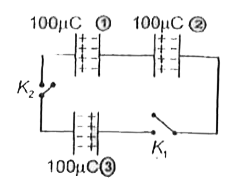Rows of capacitors 1,2,4,8…..∞ capacitors, each of capacitance 2μF, are connected in parallel as shown in figure. The potential difference across AB = 10 V, then

a. Total capacitance across AB is 4μF
b. Charge of each capacitor will be same
c. Charge on the capacitor in the first row is more than on any other capacitor
d. Energy of all the capacitors is 200μJ
The correct Answer is:A, C, D
Step by step video & image solution for Rows of capacitors 1,2,4,8 …..infty capacitors, each of capacitance 2 muF, are connected in parallel as shown in figure. The potential difference across AB = 10 V, then by Physics experts to help you in doubts & scoring excellent marks in Class 11 exams.
Updated on:21/07/2023Similar Questions
Knowledge Check
The potential difference between points A and B is
 A2B5C11D18
A2B5C11D18
Six equal capacitors each of capacitance 10μF are connect as shown in the figure. Then the equivalent capacitance between A and B is
View SolutionFour capacitors each of capacity 8μF area connected with each other as shown in figure. The equivalent capacitance between points X and Y will be

View SolutionSix identical capacitors each of capacitance 2μF are connected as shown below. The equivalent capacitance between the points A and B is
View SolutionThree identical charged capacitors each of capacitance 5 μF are connected as shown in figure. Potential difference across capacitor (3), long time after the swithces K1andK2 are closed , is

View SolutionSix capacitors each of capacitance 1μF are connected as show in . Find the charge flowing in direction 1 as shown in the figure will be
 .
.
View SolutionThree capacitors 3μF,6μF and 6μF are connected in series to source of 120 V. The potential difference in volt, across the 3μF capacitor will be
View SolutionTwo, capacitors A and B are connected in series across a 100V supply and it is observed that the potential difference across them are 60V and 40V. A capacitor of 2pF capacitance is now connected in parallel with A and the potential difference across B rises to 90V. Determine the capacitance of A and B
View Solution




